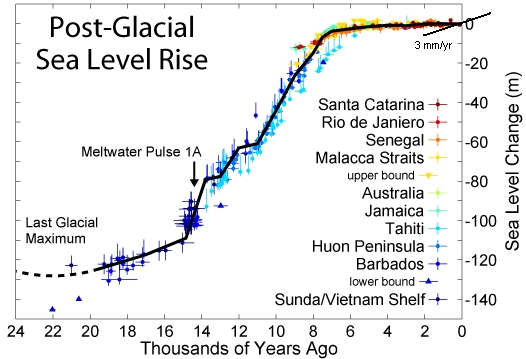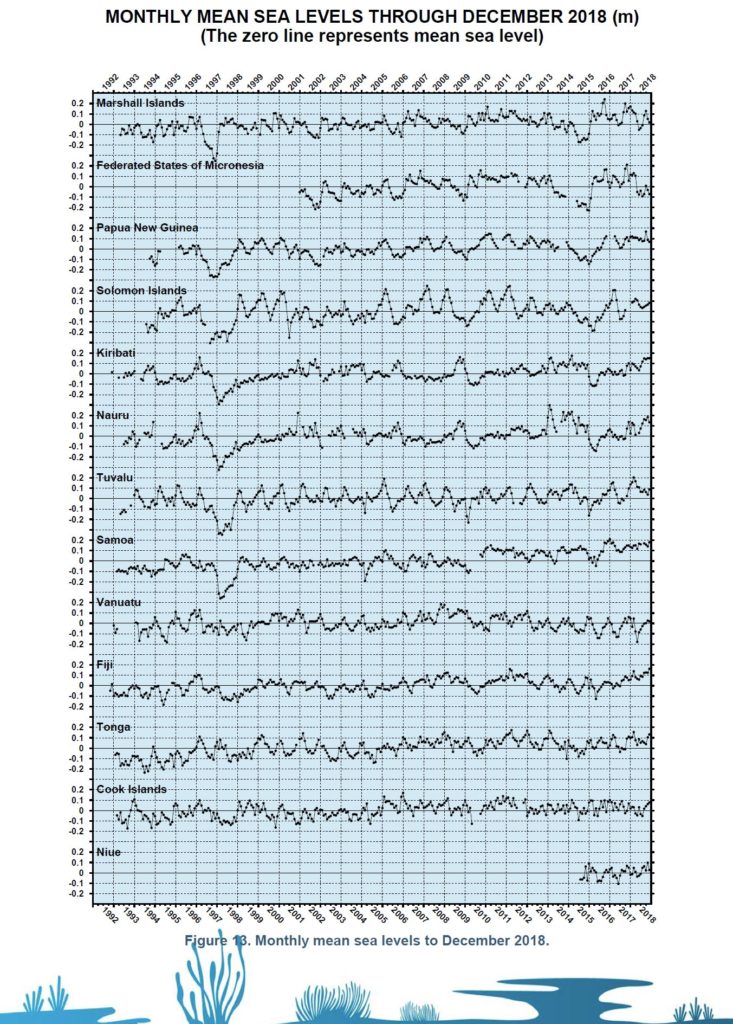Professor Andreas Neef, a disaster recovery expert at the University of Auckland, very handsome and seemingly a qualified authority on climate science, said extraordinary things in the Herald on Friday. All of it was aimed at raising alarm among New Zealanders for the climate calamities soon to strike us. But nothing he says is supported by real-world data.
Professor Andreas Neef, a disaster recovery expert at the University of Auckland’s Faculty of Arts.
Professor Neef says the existence of many islands in the Pacific is threatened by an “extremely desperate” disaster scenario of global warming causing rising sea levels, which are “having a disastrous impact.” This is just desperate language that has a disastrous impact only on our sensibilities.
For if sea levels have been rising, it’s not because of warming. I’ll show shortly that there’s been no significant warming, but first hear what regular readers already know about coral atolls. In SEA-LEVEL CHANGE – Living with uncertainty, by Willem P. de Lange and Robert M. Carter (2014), a GWPF report, the authors describe coral atoll formation and make it clear that many calamities, real and theoretical, are incorrectly blamed on sea level rise. This is what the two scientists say:
What about coral atolls?
Relentless media attention has ensured that the alleged threat to coral atolls from sea-level rise remains in the public eye, with the Tuvalu Islands receiving the most publicity.
The origin of coral atolls was famously first explained by Charles Darwin, who noted that they were reef sandbank complexes situated on top of sinking, extinct volcanoes. Such atolls are made up of detrital coral sand that has been eroded from the living reef communities that develop as a volcano submerges and which is washed into shallow banks. Subsequently, some of these sand banks develop a small freshwater lens derived from rainfall, and become temporarily stabilised by vegetation to the point that they can sustain human habitation. Seldom more than a metre or two above sea level, all atolls and related sand-clay islands are at the continuing mercy of the same wind, waves, tides and weather events that built them. They are dynamic features of the seascape, and over timescales of decades to centuries they erode here, grow there and sometimes disappear beneath the waves forever. Thus a coral atoll is not so much a ‘thing’ as it is a process, and they are obviously not good places in which to develop major human population centres.
Because they are located so close to sea-level, it is commonly assumed that atolls are vulnerable to rising sea-level. However, investigations into the processes that govern their formation, evolution and stability indicate that they are very resilient to sea level changes, provided human activities do not disrupt the natural processes. Perhaps counter-intuitively, overwashing of the islands—by storm waves, storm surges, high tides and tsunami—is an important mechanism for increasing their elevation, depositing new layers of sediment each time (Kench et al. 2006).
… Conclusion
The dynamic nature of an atoll is exacerbated, and its integrity jeopardized, when it is subjected to the environmental pressures created by a growing human population. Sand mining, construction project loading, and rapid groundwater withdrawal all cause local lowering of the ground surface, and thereby encourage marine incursion quite irrespective of any sea-level change.
It is these processes in combination with episodic natural hazards like tides and storms, and not global sea-level change, which provide the alarming footage of marine flooding that from time to time appears on our television news screens.
If islanders and their governments were well advised, they might ask for engineering assistance instead of simply waiting around dreaming of a share in the trillions promised by the IPCC as “climate justice” in what has turned out to be a sickening parody of foreign assistance.
Sea level data
The Herald article says:
NASA has warned global sea levels have risen by about 17cm in the last 100 years alone while Fiji has recorded an average sea level increase of 6mm every year since 1993, a figure above the global average (about 3.17mm).
The SEAFRAME reports reveal that the sea-level rise of 17 cm in 100 years is entirely normal. Sea level rose by 1.7 mm per year, which it has done for 8000 years. To call this rate of sea level rise a “warning” is grotesquely misleading. As the AR5 SPM (p. 11) confirms:
Over the period 1901 to 2010, global mean sea level rose by 0.19 [0.17 to 0.21] m (see Figure SPM.3).
Sea level rise at Fiji has been nothing like +6 mm every year since 1993. Instead, Prof Neef should have said the annual movements have been extremely variable, going up and down by up to 200 mm (8 inches) a year. In December, it was sitting about 156 mm (6 inches) above the mean, but one look at the graph shows it’s been all over the place in the meantime. The global annual average increase was about 3.17 mm. Both these facts can be challenged.
Page one of the Executive Summary of the latest SEAFRAME report in December says: “At Fiji, the monthly mean sea level is the highest on record.”
The difference in annual average sea level at Fiji between 1993 and today was about 150 mm. So, yes, sea level rise might have averaged about 6 mm per year since 1993—but it was highly variable—and sea level there in December was the “highest on record”—but it also reached the same level in 2011, meaning that it’s not unprecedented and it’s not because of a rising trend.
What is the global annual average? We already checked the AR5 SPM (p. 11), which says sea level rose 190 mm between 1901 and 2010 (1.74 mm/yr), so that tells us the claim of 3.17 mm from 1993 to 2010 is about a doubling; where does the number come from? That’s also on page 11:
It is very likely that the mean rate of global averaged sea level rise was … 3.2 [2.8 to 3.6] mm yr–1 between 1993 and 2010.
That’s an acceleration in 17 years that suddenly doubles the rate for the last 8000 years, but the tide gauges don’t report it. The claim is only from satellite observations, obviously from far offshore, because we don’t observe it on the coast. There’s no reason to believe that this new, higher rate will soon affect our foreshore.
Satellite altimeters and tide gauges
Dr Willem de Lange tells me the discrepancy may have something to do with errors in the calculation of the geoid (the hypothetical shape of the ocean surface), with which the satellite measurements are compared. Plus an amount is added to account for what is claimed to be a theoretical, unobserved increase in the volume of the ocean basins caused by tectonic movement. But they can’t add anything to the tide gauge measurements—it is what it is.
There’s no evidence that an increase in sea level rise is imminent. The only indication is the output of unverified computer models that the IPCC has admitted run too hot. The New Zealand tide gauges show sea level rising in some places, declining in others. Few people know this, especially among reporters.
This graph from the December 2018 report from the Pacific Sea Level Monitoring Project shows sea levels at each station since installation around 1992. Prof Neef said Fiji experienced 6 mm/year since 1993, which is supported by this graph. Except that all the graphs show a lot of variation, with sea level at Fiji going above the 100 mm (0.1) mark three times, so it’s not a warming trend.
The reports advise caution
Please exercise caution in interpreting the overall rates of movement of sea level – the records are too short to be inferring long-term trends and have not been corrected for land movement or other parameters that may influence the reported rates.
Professor Neef is twice mischievous: first to imply a rising trend of 6 mm per year at Fiji when it’s nothing of the sort and second to cite it as though it’s disastrous, when you could cherry-pick Micronesia for a large fall, or Kiribati, Nauru, Samoa or Tonga along with Fiji for substantial rises (judged improperly by the start and end points alone).
The truth is, global warming is not causing rising sea levels in the Pacific, so the “disastrous impact” he says is occurring is not occurring. Curious that he gives no examples of the impacts of rising sea levels. The disasters he mentions have nothing to do with the sea level and his account is full of woolly terms such as “could”, “likely to become uninhabitable”, “this may no longer be the case if sea temperatures continue to rise.”
Still, his very lack of certainty means that “the seriousness of climate change-induced disaster can’t be underestimated.” Well, yes it can.
A swamp by any other name would smell as foul
Neef appears not to be a serious natural scientist (correct me if this is wrong). He teaches in the Arts Faculty and according to his page at Auckland University he holds MSc and PhD degrees in Agricultural Economics and the soft subjects of Development Policy and Rural Sociology [not usually considered natural sciences] from the University of Hohenheim in Stuttgart, Germany. He says he advised the German Parliament on “issues of global food security and on societal and political discourses on the commodification of biodiversity and ecosystem services.”
I won’t try to argue with that (knowing a swamp when I smell methane), but I wonder why he hectors the New Zealand public on climate, which is far outside his field. Anyway, this is what the last 20,000 years of sea level looks like—total rise was about 130 metres (430 feet), but mild and steady for eight millenia:

Global sea level measured by tide gauges has risen at about 1.8 mm per year for about the last 8000 years. Satellite observations began in 1993 and report a higher rate of rise, about 3.2 mm/yr, but this is unexplained. I am told by Dr Willem de Lange the discrepancy may have something to do with errors in the calculation of the geoid (the hypothetical shape of the ocean surface), with which the satellite measurements are compared. No significant rise has been reported by tide gauges, except where the land is sinking, which means the height of the sea right beside our infrastructure, the only place it matters, has not greatly changed. These facts refute the constant claims from warmsters of accelerating sea level rise.
New Zealand will never face the same situation as low-lying atolls and to state that we soon will is highly misleading … oh, but he doesn’t, does he? He says we “could face what’s happening in the Pacific.” Except that we are in the Pacific, it’s not affecting us and he mischaracterises the whole “extremely desperate” disaster scenario of global warming causing rising sea levels, which are not “having a disastrous impact.”
Infants and teenagers know nothing
Consider the recurring theme of galloping global mean temperature: the truth is, it has hardly risen in 20 years. No infant, child or teenager has experienced global warming. The global datasets of UAH, HadCRUT4, NCDC and GISS all show temperatures in 1998 are virtually indistinguishable from today’s. It’s curious that RSS temperatures were quite similar to UAH, but since the update in 2015, RSS is running about 0.2 °C hotter than UAH.
Dr Neef knows nothing about many aspects of climate science—but neefer mind, we can help him.
Let us hope that the good Professor Neef sticks to disaster recovery and leaves the long-suffering Pacific Islanders alone in their counterfeit climate calamities. They have more than enough real ones to cope with—perhaps he might inquire about those.
Views: 242

